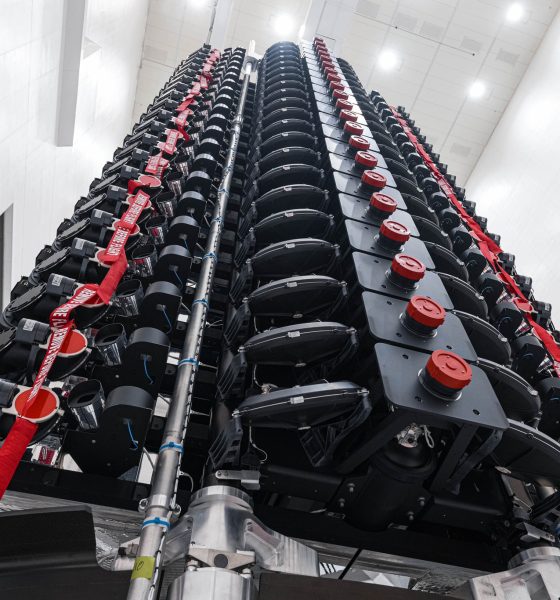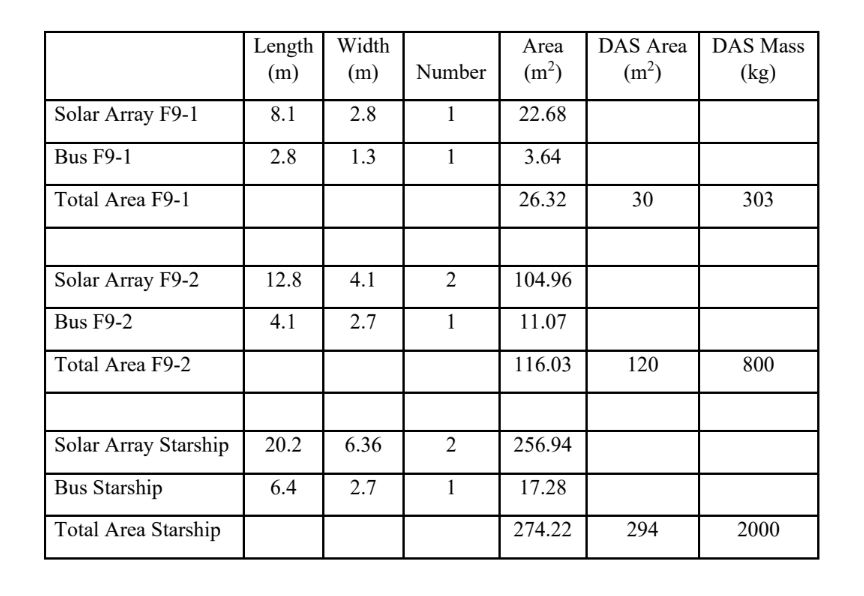

News
SpaceX unveils next-gen Starlink V2 Mini satellites ahead of Monday launch
SpaceX has released official specifications and photos of its next-generation Starlink V2 Mini satellites, which are set to launch for the first time as early as Monday, February 27th.
The new satellites are the future of SpaceX’s Starlink constellation, and the information the company revealed helps demonstrate why.
The update that's rolling out to the fleet makes full use of the front and rear steering travel to minimize turning circle. In this case a reduction of 1.6 feet just over the air— Wes (@wmorrill3) April 16, 2024
SpaceX’s confusingly-named Starlink 6-1 mission will carry the first 21 Starlink V2 satellites into low Earth orbit (LEO) as early as 1:38 pm EST (18:38 UTC) on Monday, February 27th. The satellites will operate under SpaceX’s Starlink Gen2 FCC license, which currently allows the company to launch up to 7,500 of a nominal 29,998 satellites. At the same time as it continues to fill out its smaller 4,408-satellite Starlink Gen1 constellation with smaller V1.5 satellites, SpaceX has already begun launching the same smaller V1.5 satellites under the Gen2 license.
Eventually, those smaller and less capable satellites will likely be replaced with larger V2 satellites, but SpaceX appears to have decided that quickly adding suboptimal capacity is better than waiting for an optimal solution. In theory, that optimal solution is larger Starlink V2 satellites. As discussed in a previous FCC filing, SpaceX intends to operate up to three different types of Starlink satellites in its Starlink Gen2 constellation. The first variant is likely identical to the roughly 305-kilogram (~673 lb) Starlink V1.5 satellites that make up most of its Starlink Gen1 constellation.

Meanwhile, SpaceX has already built and delivered dozens of full-size Starlink V2 satellites to Starbase, Texas. Those more optimal spacecraft reportedly weigh anywhere from 1.25-2 tons (2750-4400 lb) each, offer almost 10 times more bandwidth than V1.5 satellites, and are so large and ungainly that they can only be launched by SpaceX’s next-generation Starship rocket. Starship is substantially delayed, however, so SpaceX chose to develop a third Starlink satellite variant combining many of the full-size V2 benefits into a package that can be launched by SpaceX’s existing Falcon 9 rocket.
Prior to SpaceX’s February 26th tweets, all that was known about those Starlink “V2 Mini” satellites were a few specifications included in a response to the FCC. The new information provided by SpaceX appears to confirm some of those specifications. For example, knowing that Falcon 9 will carry 21 V2 Mini satellites and that the rocket’s current payload record is 17.4 tons, each V2 Mini satellite likely weighs no more than 830 kilograms (~1830 lb). That’s very close to the 800-kilogram estimate provided in the October 2022 filing.
More importantly, SpaceX revealed that each Starlink V2 Mini satellite will have more powerful antennas and access to a new set of frequencies. Combined, each satellite will have up to “~4x more capacity…than earlier iterations” like Starlink V1. Compared to current V1.5 satellites, that means that Starlink V2 Mini could squeeze approximately 50% more network capacity out of each unit of satellite mass. As a result, even though the larger V2 Mini design has reduced the number of satellites Falcon 9 can launch almost threefold, the 21 V2 Mini satellites it can launch will add ~50% more bandwidth than the ~57 V1.5 satellites it would have otherwise launched.
The larger satellites mean that it will take three times as many Falcon 9 launches to expand Starlink V2 coverage, but the areas that are covered will have the capacity to serve several times more customers or deliver much higher bandwidth to the same number of customers.
SpaceX also announced that it has developed a new argon-fueled Hall effect thruster for Starlink V2 satellites. To avoid the high costs of xenon propellant, the most common choice of fuel for electric propulsion systems, SpaceX already developed a first-of-its-kind krypton Hall effect thruster for Starlink V1 and V1.5 satellites. Spread over the almost 4000 Starlink V1.x satellites SpaceX has launched since May 2019, the relatively low cost of krypton (roughly $500-1500/kg vs. $3000-10,000+/kg for xenon) has likely saved the company hundreds of millions of dollars.
The shift from krypton to argon could be similarly beneficial. Relative to krypton, the argon required to fuel Starlink V2 satellites will be practically free. 99.999%-pure argon can be purchased in low volumes for just $5 to $17 per kilogram, and each Starlink V2 Mini satellite will likely need less than 80 kilograms. SpaceX likely spent around $50 million (+/- $25M) on krypton for the almost 4000 Starlink V1 satellites it’s launched to date. As a result, even if every Starlink V2 satellite needs an excessive 200 kilograms of argon, fueling its next constellation of almost 30,000 V2 satellites could cost SpaceX less than fueling 4000 V1 satellites.
Tune in below around 1:30 pm EST (18:30 UTC) to watch SpaceX’s first Starlink V2 launch live.

Elon Musk
Elon Musk’s X will start using a Tesla-like software update strategy
The initiative seems designed to accelerate updates to the social media platform, while maintaining maximum transparency.

Elon Musk’s social media platform X will adopt a Tesla-esque approach to software updates for its algorithm.
The initiative seems designed to accelerate updates to the social media platform, while maintaining maximum transparency.
X’s updates to its updates
As per Musk in a post on X, the social media company will be making a new algorithm to determine what organic and advertising posts are recommended to users. These updates would then be repeated every four weeks.
“We will make the new 𝕏 algorithm, including all code used to determine what organic and advertising posts are recommended to users, open source in 7 days. This will be repeated every 4 weeks, with comprehensive developer notes, to help you understand what changed,” Musk wrote in his post.
The initiative somewhat mirrors Tesla’s over-the-air update model, where vehicle software is regularly refined and pushed to users with detailed release notes. This should allow users to better understand the details of X’s every update and foster a healthy feedback loop for the social media platform.
xAI and X
X, formerly Twitter, has been acquired by Elon Musk’s artificial intelligence startup, xAI last year. Since then, xAI has seen a rapid rise in valuation. Following the company’s the company’s upsized $20 billion Series E funding round, estimates now suggest that xAI is worth tens about $230 to $235 billion. That’s several times larger than Tesla when Elon Musk received his controversial 2018 CEO Performance Award.
As per xAI, the Series E funding round attracted a diverse group of investors, including Valor Equity Partners, Stepstone Group, Fidelity Management & Research Company, Qatar Investment Authority, MGX, and Baron Capital Group, among others. Strategic partners NVIDIA and Cisco Investments also continued support for building the world’s largest GPU clusters.
News
Tesla FSD Supervised wins MotorTrend’s Best Driver Assistance Award
The decision marks a notable reversal for the publication from prior years, with judges citing major real-world improvements that pushed Tesla’s latest FSD software ahead of every competing ADAS system.

Tesla’s Full Self-Driving (Supervised) system has been named the best driver-assistance technology on the market, earning top honors at the 2026 MotorTrend Best Tech Awards.
The decision marks a notable reversal for the publication from prior years, with judges citing major real-world improvements that pushed Tesla’s latest FSD software ahead of every competing ADAS system. And it wasn’t even close.
MotorTrend reverses course
MotorTrend awarded Tesla FSD (Supervised) its 2026 Best Tech Driver Assistance title after extensive testing of the latest v14 software. The publication acknowledged that it had previously criticized earlier versions of FSD for erratic behavior and near-miss incidents, ultimately favoring rivals such as GM’s Super Cruise in earlier evaluations.
According to MotorTrend, the newest iteration of FSD resolved many of those shortcomings. Testers said v14 showed far smoother behavior in complex urban scenarios, including unprotected left turns, traffic circles, emergency vehicles, and dense city streets. While the system still requires constant driver supervision, judges concluded that no other advanced driver-assistance system currently matches its breadth of capability.
Unlike rival systems that rely on combinations of cameras, radar, lidar, and mapped highways, Tesla’s FSD operates using a camera-only approach and is capable of driving on city streets, rural roads, and freeways. MotorTrend stated that pure utility, the ability to handle nearly all road types, ultimately separated FSD from competitors like Ford BlueCruise, GM Super Cruise, and BMW’s Highway Assistant.
High cost and high capability
MotorTrend also addressed FSD’s pricing, which remains significantly higher than rival systems. Tesla currently charges $8,000 for a one-time purchase or $99 per month for a subscription, compared with far lower upfront and subscription costs from other automakers. The publication noted that the premium is justified given FSD’s unmatched scope and continuous software evolution.
Safety remained a central focus of the evaluation. While testers reported collision-free operation over thousands of miles, they noted ongoing concerns around FSD’s configurable driving modes, including options that allow aggressive driving and speeds beyond posted limits. MotorTrend emphasized that, like all Level 2 systems, FSD still depends on a fully attentive human driver at all times.
Despite those caveats, the publication concluded that Tesla’s rapid software progress fundamentally reshaped the competitive landscape. For drivers seeking the most capable hands-on driver-assistance system available today, MotorTrend concluded Tesla FSD (Supervised) now stands alone at the top.
News
Elon Musk’s Grokipedia surges to 5.6M articles, almost 79% of English Wikipedia
The explosive growth marks a major milestone for the AI-powered online encyclopedia, which was launched by Elon Musk’s xAI just months ago.

Elon Musk’s Grokipedia has grown to an impressive 5,615,201 articles as of today, closing in on 79% of the English Wikipedia’s current total of 7,119,376 articles.
The explosive growth marks a major milestone for the AI-powered online encyclopedia, which was launched by Elon Musk’s xAI just months ago. Needless to say, it would only be a matter of time before Grokipedia exceeds English Wikipedia in sheer volume.
Grokipedia’s rapid growth
xAI’s vision for Grokipedia emphasizes neutrality, while Grok’s reasoning capabilities allow for fast drafting and fact-checking. When Elon Musk announced the initiative in late September 2025, he noted that Grokipedia would be an improvement to Wikipedia because it would be designed to avoid bias.
At the time, Musk noted that Grokipedia “is a necessary step towards the xAI goal of understanding the Universe.”
Grokipedia was launched in late October, and while xAI was careful to list it only as Version 0.1 at the time, the online encyclopedia immediately earned praise. Wikipedia co-founder Larry Sanger highlighted the project’s innovative approach, noting how it leverages AI to fill knowledge gaps and enable rapid updates. Netizens also observed how Grokipedia tends to present articles in a more objective manner compared to Wikipedia, which is edited by humans.
Elon Musk’s ambitious plans
With 5,615,201 total articles, Grokipedia has now grown to almost 79% of English Wikipedia’s article base. This is incredibly quick, though Grokipedia remains text-only for now. xAI, for its part, has now updated the online encyclopedia’s iteration to v0.2.
Elon Musk has shared bold ideas for Grokipedia, including sending a record of the entire knowledge base to space as part of xAI’s mission to preserve and expand human understanding. At some point, Musk stated that Grokipedia will be renamed to Encyclopedia Galactica, and it will be sent to the cosmos.
“When Grokipedia is good enough (long way to go), we will change the name to Encyclopedia Galactica. It will be an open source distillation of all knowledge, including audio, images and video. Join xAI to help build the sci-fi version of the Library of Alexandria!” Musk wrote, adding in a later post that “Copies will be etched in stone and sent to the Moon, Mars and beyond. This time, it will not be lost.”








